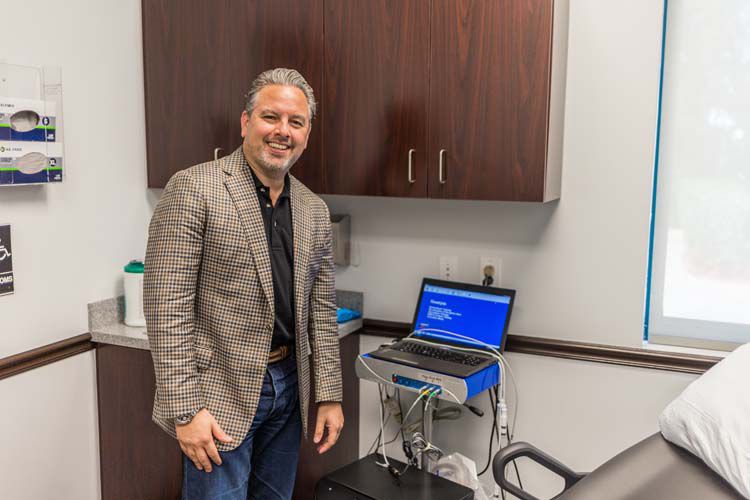
Here’s the bad news: Overactive bladder – or OAB – is incredibly common.
Some 33 million Americans will seek medical help for OAB this year, and the Urology Care Foundation speculates that many millions more are just too embarrassed to talk to their doctor about it.
OAB can and does force people – consciously or sub-consciously – to avoid social gatherings or spending time with family. It can even make them put off vacations because they’re afraid their sudden and intense urges to urinate may lead to “an accident” that will embarrass them.
Here’s the good news: Urologist Dr. Hugo Davila, with Florida Healthcare Specialists here in Vero Beach, says OAB can now be effectively (and discreetly) treated.
As with just about any medical problem, proper diagnosis is key.
Davila explains why: “If I tell you the symptoms of prostatitis, they would be similar to the symptoms of overactive bladder. If I tell the symptoms of a benign growth of your prostate or BPH, they will be similar. So it can be difficult to differentiate between what overactive bladder truly is and is not.”
Moreover, urinary tract infections, tumors, bladder stones, diet, excessive caffeine or alcohol consumption along with a whole host of prescription medications, including diuretics, antidepressants and sedatives, can all create symptoms similar to OAB or they can exacerbate it.
The bladder, brain and spinal cord all play a role in OAB.
The bladder is obvious. As the Mayo Clinic says, “The kidneys produce urine, which drains into your bladder. When you urinate, urine passes from your bladder through an opening at the bottom and flows out a tube called the urethra.”
As the bladder starts to fill with urine from the kidneys, nerve signals are sent from the bladder to the brain through the spinal cord. The brain, under normal circumstances, will send signals back to the bladder essentially saying, “Wait. You’re not full yet,” and the bladder relaxes.
Overactive bladder occurs when the bladder ignores or doesn’t receive those “wait” signals from the brain, resulting in an urgent need to urinate.
Multiple sclerosis, Parkinson’s disease and traumatic spinal injuries can disrupt these communications in some – but certainly not all – cases.
Many people with OAB will leak urine when they feel that sudden urge. Others may have to get up and go to the bathroom multiple times during the day and again at night. Or, as Davila puts it, “Sometimes patients say their bladder has taken control of their life.”
Fortunately, help is readily available. “Most of the time,” says Davila, “you don’t have to see a urologist if you’re having symptoms. You can talk to your family doctor.”
The first step might be a bladder diet, which involves a list of foods and beverages that may irritate the bladder and should be avoided, as well as a list of alternative food and drink choices.
Next your doctor might ask you to keep a three-day “bladder diary” to track how frequently you need to urinate. There’s even an app for that: Bladder Pal 2 is a smartphone app on iTunes that helps people track their bladder health.
If diet changes don’t solve the problem, medication might. “There are basically two families of medications,” explains the affable Davila. “One is what we call the anticholinergic drugs. They act and work through specific receptors in the bladder. The main idea of these medications is to relax the bladder. And there are many on the market.”
But there’s also something brand new on the market, which clearly intrigues Davila. The drug Myrbetriq works on different receptors and doesn’t have the side effects (dry mouth, constipation and potential memory loss) of the anticholinergic drugs.
Then Davila brings up an even more intriguing treatment which, as he says, “nobody talks about,” but that has produced impressive results since it first came onto the scene in 1998.
A pacemaker for the bladder.
“By stimulating that nerve going to your bladder, we are making the bladder relax. For people who get the pacemaker, their quality of life gets so much better from day one. They come back and say, ‘Thank you Dr. Davila. Finally I can drive from Orlando to Miami without stopping at 20 gas stations.’”
Looking for a less intrusive solution? Davila can offer that, too.
Tibial nerve stimulation has also proved effective for OAB. The tibial nerve in the foot, says Davila, can be massaged “for 30 minutes in my office once a week for 12 weeks,” and in effect helps to “re-train” the bladder.
Finally, in what might be the most surprising treatment of all, Botox injections – the same Botox used by plastic surgeons to make facial wrinkles disappear – can also be used to treat OAB.
However, Davila warns there are plenty of potential problems inherent with using the same toxin that causes botulism to treat your bladder, so clearly that’s a treatment that should only be undertaken after extensive conversations with your physician.
Fortunately, for the 33-plus million Americans who suffer from OAB, there are several less risky and equally or more effective treatment options available.
Dr. Hugo Davila is with Florida Healthcare Specialists at 3730 7th Terrace, Suite 101 in Vero and 1627 U.S. 1 in Sebastian. The phone number is 772-581-0528.



